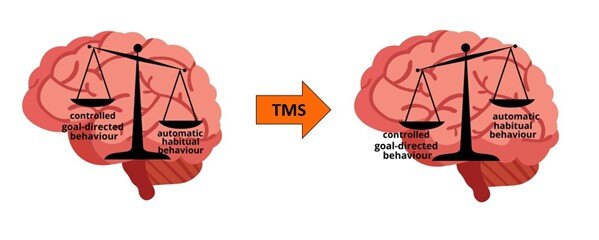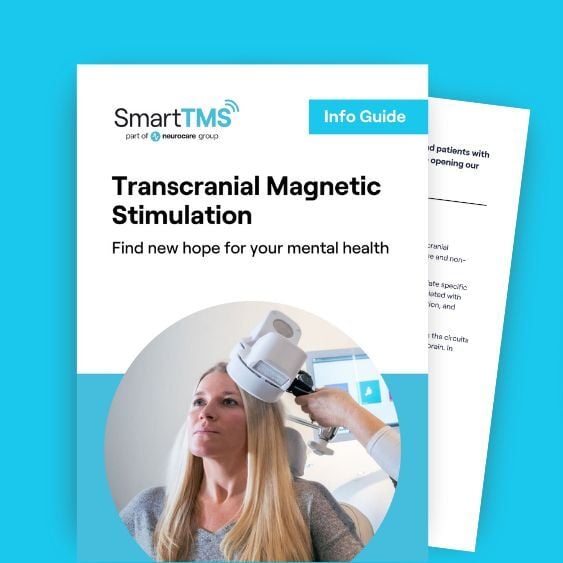Brain circuitry changes in addiction and how TMS can address them
April 4, 2022 - Smart TMS

The conference
I have recently attended the Conference for Addiction Psychiatrists, in which various experts in the field presented the latest addiction research. Having treated a number of patients with addictions at the Hampshire clinic with TMS, I found it an informative experience. I enjoyed hearing experts discuss the neurobiology of these disorders, as well as novel ways of treatment.
One of the talks I thoroughly enjoyed was Dr. Filippo Ghin’s presentation of his latest paper, regarding brain mechanisms underlying addiction, specifically in alcohol use disorder and the need for non-invasive treatments that address those mechanisms.
Substance abuse
Substance use disorders are one of the leading causes of morbidity and mortality worldwide. While knowledge of the causes and mechanisms of addiction has improved, effective therapeutic options are still limited. Substance use disorders are characterised by certain imbalances in circuits of the brain, where the therapeutic options available do not address these directly, but instead focus on reducing cravings and withdrawal symptoms.
Alcohol use disorder (AUD) is characterised by drinking in excess and losing control over one’s alcohol intake despite negative consequences. According to the World Health Organization, it is estimated that worldwide, 3 million deaths every year are a result of harmful use of alcohol, this representing a causal factor in more than 200 disease and injury conditions. Relapse rates remain very high despite large progress made in alcohol use disorder treatment.
Changes in the brain
Neuroimaging studies show that the habit of drinking excessively leads to a change in the brain circuits, favouring automatic habit over conscious and controlled behaviour. At the brain level, when occasional drinking turns into a habit, the decision to drink is not made by the prefrontal cortex anymore, but by a deeper structure within the brain called the striatum. The prefrontal cortex is responsible for conscious decision making, while the striatum is concerned with habitual responses. In healthy individuals, the frontal cortex inhibits the striatum but in AUD patients, that response is much weaker due to long term changes caused by alcohol.

The prefrontal cortex becomes less active while the striatum and other areas involved in automatic behaviour are more active. This change at the level of brain circuits then has an impact on the balance of chemicals in the brain, leading to a different chemical profile in the brain when the person consumes alcohol and withdrawal symptoms when the brain tries to go back to its original chemical profile.
Unfortunately, these are long-lasting changes that do not revert upon ceasing use, which leads to high risk of relapse in previous AUD sufferers. Pharmacological interventions neglect the potential benefits of directly targeting the brain mechanisms underlying the imbalance between controlled and automatic behaviour. Neuromodulation techniques such as TMS (transcranial magnetic stimulation) have the potential to induce long-term modifications to restore this balance by increasing the activity of the prefrontal cortex.
TMS treatment
TMS works by creating an electro-magnetic field that can be targeted to specific areas of the brain, to either increase or decrease activity in that area. Repetitive TMS influences brain activity in the short and long term by inducing neuroplasticity both locally, at the surface of the brain, under the stimulation coil, and in deeper structures of the brain, acting on the whole network that underlies addiction. The long-term changes induced by rTMS have the potential to affect behaviours relating to alcohol craving, intake and relapse and restore conscious control over behaviours.
At Smart TMS, we treat patients with alcohol use disorders with high frequency stimulation over the frontal left side of the brain. 50% of our patients see a complete reduction in their cravings by the end of the treatment and on average, there is a 80% reduction in craving across all of our addiction patients. Furthermore, our continuous care treatment packages are designed to prevent relapse by strengthening those brain changes that occurred as a result of TMS.
Conclusion
In conclusion, alcohol addiction is a result of changes at the level of brain circuits that inhibit habitual behaviours and promote voluntary action. The brain of a person addicted to alcohol is less able to prioritize goal-directed actions and instead prioritizes habits, to the detriment of the person. For patients that receive successful pharmaceutical treatment, relapse rates still remain high, therefore there is a need for better interventions that address these brain changes. TMS is a treatment that can address this imbalance at the root cause and restore the balance of the brain, allowing you to take conscious control over your life.
Author, Roxy Ioan,
Smart TMS Hampshire Practitioner










